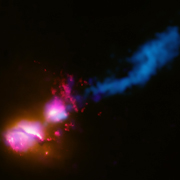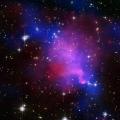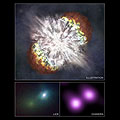Disclaimer: This material is being kept online for historical purposes. Though accurate at the time of publication, it is no longer being updated. The page may contain broken links or outdated information, and parts may not function in current web browsers. Visit chandra.si.edu for current information.
Black Holes, Dark Matter, and a Possible New Way to Self-Destruct:
Recent Chandra Science Highlights
by WKTDecember 17, 2007 ::

Composite Image of 3C321
Credit: X-ray: NASA/CXC/CfA/D.Evans et al.; Optical/UV: NASA/STScI; Radio: NSF/VLA/CfA/D.Evans et al., STFC/JBO/MERLIN
The highlights of discoveries made with Chandra in the past year include an exploration of the explosive activity associated with a supermassive black hole (3C321), a puzzling concentration of dark matter found in the aftermath of a collision between giant clusters of galaxies (Abell 520) and the potential discovery of a new type of supernova.
The hot remains of supernovas, called supernova remnants, continue to be the source of many of Chandra's most detailed and impressive images. The force of a supernova explosion creates shock waves that heat the stellar debris to millions of degrees, causing it to glow in X-rays for thousands of years.
Astronomers have traditionally placed observed supernovas in one of two main types: supernovas that occur when the central core of a massive star collapses (core-collapse supernovas - G292 and Cassiopeia A are examples), and supernovas that are triggered when a white dwarf star becomes unstable due to the accumulation of matter from a nearby companion star. The white dwarf undergoes a thermonuclear explosion known as a Type 1a supernova when its mass becomes about 40% larger than the sun (Kepler's SNR).
The impact of both types of explosions is far-reaching. Shock waves from the expanding debris stir up and heat the interstellar gas, and distribute the heavy elements necessary for the formation of planets and life. Core-collapse supernovas produce most of the oxygen in the universe, and Type 1a supernovas produce most of the iron. Supernovas are the source of almost all of the elements heavier than carbon.
In nearby supernova remnants, meaning ones less than about two hundred thousand light years from Earth, Chandra reveals this seeding of interstellar space in action. Hot clouds and filaments rich in oxygen, silicon, iron and other elements are imaged directly. In viewing these images, we can, in a fundamental way, better understand our own origins and, with the poet Wordsworth, get a glimpse of "that immortal sea which brought us hither."
Powerful stuff, but in the past year, the Chandra image with the most "star power" turned out to be a seemingly unremarkable pair of fuzzy dots in a galaxy about 240 million light years from Earth (SN 2006gy). These dots - one identified with a supernova, and the other with its host galaxy - helped astronomers to piece together a fascinating story about how this supernova produced more light than any previously recorded supernova.
The supernova SN 2006gy was first detected by an optical robotic telescope as part of the Texas Supernova Search project on September 18, 2006. It brightened slowly for about 70 days, peaked at a luminosity or intrinsic brightness equal to that of 50 billion suns - ten times brighter than its host galaxy! One promising explanation for this behavior was that a very massive star exploded into a dense circumstellar gas cloud. Debris from such an explosion would collide with the gas cloud and produce a shock wave that would convert the explosive energy into optical, ultraviolet and X-ray light. However, the Chandra data, taken 56 days after the discovery of SN 2006gy, revealed that SN 2006gy was a relatively weak X-ray emitter. This effectively ruled out the possibility that a collision with a dense circumstellar cloud produced the optical brilliance.
The hypothesis that appears to fit the data best is that SN 2006gy was a so-called pair-instability supernova. This type of supernova has been predicted to occur when an extremely massive star - one with the mass of 150 or more suns.
In such a behemoth, temperatures would rise to several billion degrees in the central region, and the usual process of converting mass into energy (E = mc2) would be reversed. Instead, energy would be converted into mass in the form of pairs of electrons and antielectrons, or positrons. The star would no longer have a source of heat to stabilize it against the enormous force of gravity.
A pair-instability supernova would produce a large amount of radioactive nickel, enough to power the extraordinary visible light output from SN 2006gy. A problem with this hypothesis is that evidence for the existence of extremely massive stars has been lacking.
The outburst observed as SN 2006gy may represent the first detected example of a pair-instability supernova. If so, it would establish that extremely massive stars can exist, and confirm another way in which stars can self-destruct.
The case is not closed, however - agreement between theory and observation is not precise. More observations and more theoretical calculations are needed, so we can expect to hear more about SN 2006gy in the years to come.
Disclaimer: This material is being kept online for historical purposes. Though accurate at the time of publication, it is no longer being updated. The page may contain broken links or outdated information, and parts may not function in current web browsers. Visit chandra.si.edu for current information.









